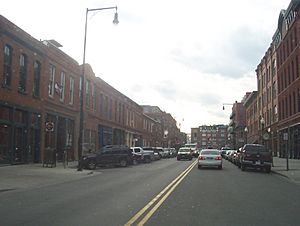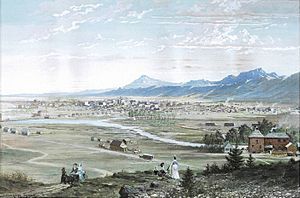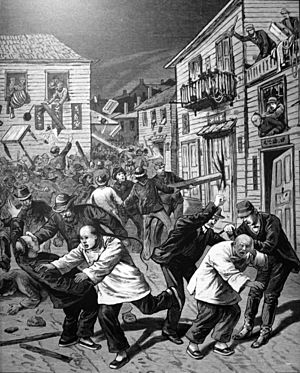Chinatown, Denver facts for kids
Quick facts for kids
Denver Chinatown
|
|
|---|---|
|
Neighborhood of Denver
|
|

Wazee Street, where Chinatown used to be, in LoDo
|
|
| Country | |
| State | Colorado |
| City | Denver |
| Chinese settlement begins | 1869 |
| Area code(s) | Area code 303 |
Chinatown in Denver, Colorado, was a special area where many Chinese Americans lived and ran businesses. It was located in what is now the LoDo part of the city. The first Chinese person to live in Denver was Hong Lee, who arrived in 1869. He lived in a small house at Wazee and F Streets and owned a laundry business.
More Chinese immigrants came to Denver the next year. Many of these men had worked on building the first transcontinental railroad or had been miners in California. After their work finished or the mines ran out of gold, they traveled across the Rocky Mountains to Denver.
In Denver, most Chinese immigrants opened laundries, which was a service many people in the city needed. However, feelings against Chinese people grew strong in many parts of the Western United States. On October 31, 1880, a large group of white people attacked Chinese residents, their homes, and businesses. This event almost completely destroyed Chinatown. The Chinese immigrants did not get any money for their lost property. Some people left Denver after the riot, but others stayed and rebuilt Chinatown. Still, they continued to face unfair treatment because of their race. By 1940, very few Asian people lived in Chinatown, and the area was torn down as part of a city improvement project.
Contents
Where Was Denver's Chinatown Located?
The exact location of Chinatown changed over time. Generally, it stretched from about 15th to 20th Streets, and from Market to Wazee Streets. There were at least three different areas known as Chinatown in Denver. The first was along Wazee Street, and the last was mainly on Market and Larimer Streets.
Why Did Chinese Immigrants Come to Denver?
Many Chinese immigrants, mostly men, moved to Colorado from the West Coast. They had worked as railroad builders, miners, and business owners. After the transcontinental railroad was finished in 1869 and gold mines in California became empty, many moved further inland. In 1870, business owners and lawmakers in the Colorado Territory actually encouraged more Chinese immigrants to come. They wanted cheap workers for farms and other jobs to help the territory grow quickly.
The Colorado Tribune newspaper announced the arrival of "the first John Chinaman in Denver" on June 29, 1869. This was Hong Lee, who started his laundry business at Wazee and F Streets. By the fall of 1870, 42 Chinese men and women lived along Wazee Street. This area became known as Chinaman's Row. Wazee might have been a Cantonese name meaning "Street of the Chinese." It was a very poor area, but it offered safety, shared culture, and community support. It was also a place to buy and sell goods important to their culture.
Denver grew very fast, but the city didn't have good systems for managing all the new people or public health. There were open sewers, rivers full of trash, and animals walking freely in the streets. Dead animals were often left in the streets. The whole city wasn't clean, but areas where Chinese, Italian, and Irish immigrants lived were often worse. Public health concerns became another reason some people wanted to remove Chinese residents from the city.
By 1880, there were 238 Chinese residents in Denver. Most of them were men who worked in laundries or as cooks. At its busiest, around 1890, there were about 980 to 1,400 Chinese immigrants in Denver. This made it the largest group of Chinese people in the Rocky Mountains. Most lived in old buildings in Chinatown. They had unique cultural traditions, like fireworks during the Chinese New Year and long funeral parades through Denver's streets.
According to William Wei, a history professor, Chinese workers were "reliable and industrious." They often took jobs that others didn't want, like searching for gold in old placer mines or doing laundry in Denver. Laundry was usually considered women's work, but there were few women in Colorado at that time. Unlike other Denver residents, most Chinese immigrants planned to save their money and return to China. They usually stayed in Colorado for about six years.
Chinatown was in a busy part of Denver, which helped Chinese businesses like laundromats make money. However, being so visible also made them targets in a society that was becoming very prejudiced against Asian people.
The Anti-Chinese Riot of 1880
Many European Americans began to distrust Chinese culture in the 1870s. Newspapers sometimes suggested that Chinese people wanted to take over the United States. Chinatown was unfairly blamed for many problems. There was also a fear that Chinese people were taking jobs from European Americans because they worked for less money.
Strong anti-Chinese feelings were encouraged by people like Denis Kearney, an Irish-American. He said that Chinese people should be removed from the country and called for a ban on them coming to the United States. During the 1860s and 1870s, race riots happened across the West. Some of the biggest were the Los Angeles massacre of 1871 and the San Francisco riot of 1877. In Colorado, the phrase "Chinese must go" was heard during attacks on Chinese people in towns like Leadville and Nederland. Chinese people were also denied fair chances for jobs and basic rights.
Chinese immigration was a big topic during the 1880 United States presidential election. On October 30, 1880, supporters of the Democratic party marched through Denver's streets. Some carried signs with anti-Chinese messages. Two days before the election, on October 31, 1880, a white mob started a race riot. One Chinese man was killed, and Chinatown was almost completely destroyed. Most buildings were robbed or burned. Every Chinese person or business that could be seen was attacked. Nearly all of Chinatown's businesses and homes were ruined, causing over $53,000 in damage. The real loss might have been much higher. For their safety, 185 Chinese men were held in jail for three days. Others hid or left town.
No one who took part in the destruction and murder in Chinatown was punished. The Chinese people were not paid for their losses. Some decided to stay in Denver and rebuild, but about 100 people left the city soon after the riot. Mattie Silks, a well-known woman, even paid for tickets for a group of women to leave town. Some families, like Chin Lin Sou's and the Lung family, managed to do well even after the riot.
Because of the strong anti-Chinese feelings in the West, lawmakers passed the Chinese Exclusion Act in 1882. This law effectively stopped people from China from immigrating to the United States. It also meant that Chinese Americans could not become citizens. This unfair law was finally removed in 1943.
Chinatown in 1885
By 1885, Chinatown was located between Wazee and Larimer Streets, and from 15th to 21st Streets, with Blake Street in the middle. Chinese residents were spread out in this area, not just living on one specific street. There were 468 people born in China living in Arapahoe County, which at that time included parts of what are now Denver, Arapahoe, and Adams counties.
What Is Chinatown's Legacy Today?
Denver's Chinese population grew to about 3,000 around the early 1900s, but they were spread out across the city. Unfair treatment and laws led to Chinatown's end. By 1940, only 110 Chinese people lived in Denver. The old, worn-out buildings were torn down during a city improvement project that year.
While there is no longer a specific Chinatown, there are areas in Denver with Asian community members. For example, there are Asian markets along South Federal Boulevard. Many Asian Pacific people now live and work in LoDo and throughout the wider Denver metropolitan area.
For a long time, the only reminder of the old Chinatown was a plaque on the corner of 20th and Blake Streets. It honored the riot and the former Chinatown. This plaque was removed in August 2022.
Members of the Colorado Asian Pacific United (CAPU) organization want a new plaque. They believe it should better represent the Chinese community and its history.
The city of Denver officially apologized for the riots on April 16, 2022. They held an event at the University of Colorado Denver. Descendants of the Chinese riot victims received special gold coins and a signed copy of the apology letter. The apology, written by Denver Mayor Michael Hancock, promised that the city would help create an Asian Pacific Historic District. It also committed to supporting murals about Asian Pacific Coloradans, developing educational programs, and founding an Asian Pacific American community museum. This museum would be the first of its kind in the Rocky Mountain Region.
Notable People
- Chin Lin Sou, a railroad supervisor, mining businessman, and merchant.




